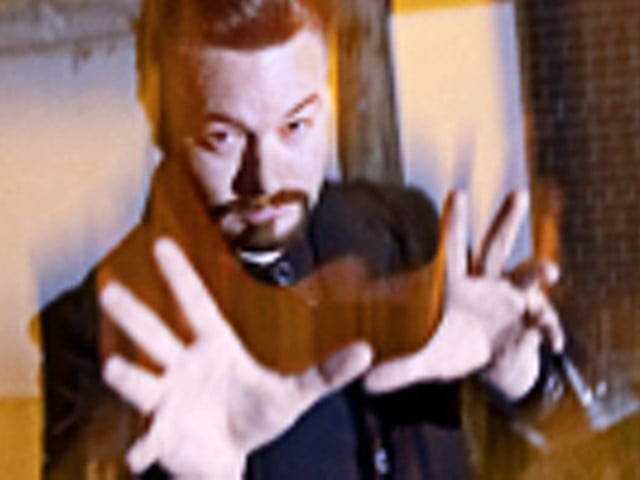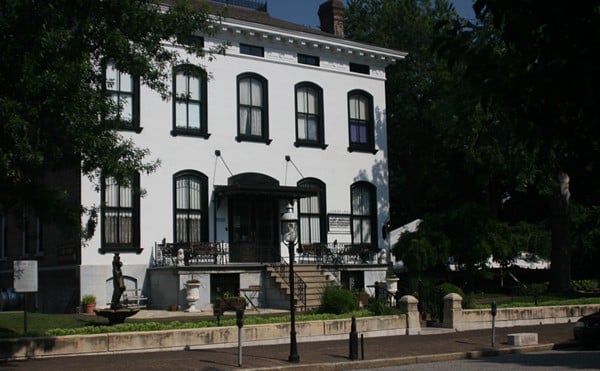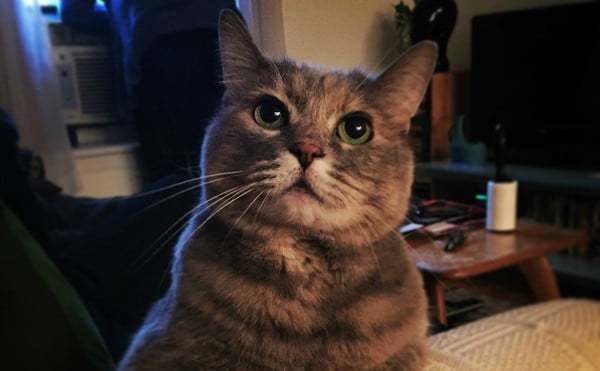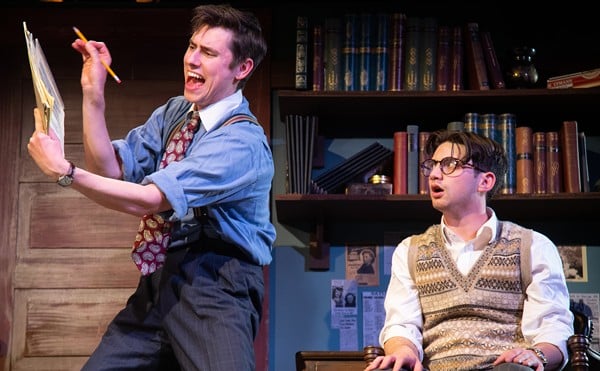Newly Reviewed
Tony Fitzpatrick: The City Etchings 1993-2003 Reviewed in this issue.
Eero Saarinen: Shaping the Future The work of this key midcentury architect, best known — locally, at least — for the Gateway Arch, is comprehensively surveyed in this traveling exhibition. A Finnish immigrant, Saarinen came from a family of diverse architectural, artistic and decorative talent and imported this totalizing approach to his work, notably diverse in style and scope, which came to ultimately define the forward thrust of the Modernist American ethos. Little more need be said here, as this show is abundantly informative — proliferating with timelines, videos, furniture pieces, models, large-scale photos, architectural models and in-depth textural addenda. It successfully adds up to an advanced education in Saarinen, but also, with timely importance, Modernism — asking important questions of this highly contestable progressive spirit, whose lingering influence has been alternately that of hope disastrously dashed or freshly, if desperately, invoked. Through April 27 at the Mildred Lane Kemper Art Museum, Forsyth & Skinker Boulevards (on the campus of Washington University); 314-935-4523 or www.kemperartmuseum.wustl.edu. Hours: 11 a.m.-6 p.m. daily (closed Tue., open till 8 p.m. Fri.).
Ongoing
All I Needed Was Everything St. Louis sculptor John Watson installs what appears like the bits and pieces of an unmoored and abandoned dockyard, seeking a new life on higher ground. A large, gangly assemblage dominates the central gallery space: a propulsive latticework of found-wood planks in assorted shades of distress, drywall-screwed together. Lining the gallery walls, smaller pieces made of similar stock hang in tidier groups, suggesting tools on a shed wall. A tone of repurposed wistfulness — if such doubling of sentiment is possible — is set by the show's pale, rescued materials and lyrical titles. Ain't Never Gonna Cry Again, Too Low to Get Too High — they evoke lines Merle Haggard sang (or should have). Like the effect of a country song, the show leaves one wanting a little more and wondering what, given more than pure sentiment, might have been possible. Also showing: Tony Fitzpatrick: Selected Works. Through February 28 at the Philip Slein Gallery, 1319 Washington Avenue; 314-621-4634 or www.philipsleingallery.com. Hours: 11 a.m.-4 p.m. Tue.-Sat.
Bad Moon Rising 3 A cacophony of rage and ruin, this traveling group show takes a laundry list of individual work and re-contextualizes it to look like a dense, end-all hideout for the current spirit of discontent. On blaring TV sets, videos depict a middle-aged woman crouching in an alleyway, looting the stuffing from a discarded Spiderman toy; a tuxedoed lounge singer repetitively crooning that sorrow conquers happiness; everyday folk testifying to having succumbed to the radical Christianity of a gay hippie preacher; and a primly suited man opening a black umbrella, setting it on fire, then dropping it and walking away. Absurd and ineffectual tangents punctuate and mitigate the larger claims of other work that points directly at specific political indiscretions. By balancing the prescriptive with the intuitive, curators Jessica Silverman and Jan Van Woensel achieve a rare success: a politically driven show that refrains from shrillness, issuing instead a kind of ominous forecast. Through February 28 at Boots Contemporary Art Space, 2307 Cherokee Street; 314-773-2281 or www.bootsart.com. Hours: noon-5 p.m. Wed. and Sat. and by appointment.
Claudio Bravo: A Bestiary A sought-after society portraitist living in Madrid in the late '60s, Bravo traded the bourgeois good life for a self-tailored monasticism in Morocco. In Tangiers, where he has resided since 1972, he has devoted his post-portrait years to painting exquisitely crafted, hyper-realist still lifes in the contemplative tradition of Chardin but flamboyantly updated with magentas, turquoises and kitsch artifacts like rumpled blue jeans and hard-pack cigarettes. This new series, traveling from the Marlborough Gallery of New York, consists simply of fine-line-rendered lithographs of native Moroccan animals standing starkly on bright white paper. What makes these radically minimal images compelling is both their sense of life-narrative conclusiveness — their simplicity's a painstakingly honed decision — and their way of evoking a kind of maturated perspective, one that's satisfied taking stock in the close observance of what's at hand and in no hurry to discover anything more. Through March 14 at the Atrium Gallery, 4728 McPherson Avenue; 314-367-1076 or www.atriumgallery.net. Hours: 10 a.m.-6 p.m. Wed.-Sat., noon-4 p.m. Sun.
Holga Polka Invitational A county fair-esque display of 40-plus contributors' wranglings with the quirk-prone Holga camera. A plastic model mass-manufactured in Hong Kong in the '80s, the Holga best lends itself to capturing modest, peripheral incidents and typically un-photo-worthy details that, in the camera's flawed soft-focus, suddenly elude fixed time. The show cultivates a spirit of unwittingly attentive viewing that invites all to recompose their daily lives as something a little more than rigidly daily. In one square image, a city phone booth appears solitary and miraculous in a bare winter forest-scape; in a small triptych, a single cactus plant leans off-kilter against blue sky, teeters blurrily in a second frame and then, in the third, is replaced by the silver angularity of an airplane wing as viewed in flight through a passenger's portal window. Through February 22 at the Regional Arts Commission, 6128 Delmar Boulevard; 314-863-5811 or www.art-stl.com. Hours: 10 a.m.-5 p.m. Mon.-Fri., noon-5 p.m. Sat.-Sun.
Houska: Hi-Def Springfield, Illinois, transplant Charles Houska — an agendaless Keith Haring whose popular brand of flamboyantly sunny "art for everyday life" has decorated everything from credit cards and vodka ads to children's-hospital doors and animal-shelter walls — abandoned the product line for the studio to create this show of new acrylic-on-canvas paintings. The yield, though, is more of the same: reliably branded imagery of a wide-eyed world of rainbowed landscapes and ubiquitous smiles, rife with blind optimism and heedless populism, that's better fit for brightening the public realm than the private auspices of a commercial gallery. Then again, opening-night sales did benefit Food Outreach, and any gallerygoer who loves brazen depictions of unflagging happiness will be undoubtedly gratified, as the work remains as innocent-seeming as a coloring book. Through February 21 at phd gallery, 2300 Cherokee Street; 314-664-6644 or www.phdstl.com. Hours: noon-4 p.m. Thu.-Sun.
Ideal (Dis-) Placements: Old Masters at the Pulitzer This exhibition of canonical canvases of slain martyrs, pious virgins and other grand dilemmas borrowed from two encyclopedic museums and replaced in naturally lit contemporary galleries is a reaffirmation of the human scale. The minimalism of Tadao Ando's building design is diffused by ornate, gilt-framed compositions that date from the fourteenth to the eighteenth century, the two historical extremes meeting precisely at the fragile effects of daylight on the predominantly figural pieces. Contemplative and reverent, the show fulfills its premise so well that it seems capable of providing a discretely intimate experience for each and every viewer. Through June 20 at the Pulitzer Foundation for the Arts, 3716 Washington Boulevard; 314-754-1850 or www.pulitzerarts.org. Hours: noon-5 p.m. Wed., 10 a.m.-5 p.m. Sat.
Locusts & Honey: New Work by Jennifer Angus In a kind of alchemical transformation, Wisconsin-based Angus pins locust, grasshopper and other bewilderingly large and intricate insect specimens in floral geometrical patterns on the walls of Craft Alliance's Grand Center gallery space, to produce delicately beautiful wallpaper patterns. The effect is something aesthetically marvelous of the purely decorative variety — trumping all the more topical curiosities that the bugs, the process of their acquisition and application and the installation's biblical allusions, evoke. With the other domestic-decorative accents of early-twentieth-century dark-wood occasional tables, jewelry drawers and display vitrines punctuating the space, what remains is a work less about fear, plague and/or bounty than about the peculiar mystery that old Americana holds. Or, more simply, how certain rooms in a home seem to have a spirit and life of their own. Through May 17 at the Craft Alliance Gallery (Grand Center), 501 North Grand Boulevard; 314-534-7528 or www.craftalliance.org. Hours: noon-6 p.m. Wed.-Sat., noon-5 p.m. Sun.
Gedi Sibony: My Arms Are Tied Behind My Other Arms Reusing discarded carpet, Sheetrock, brown-taped drop cloths, and freighting crates and blankets — the material language of contractors and art installers alike — New York-based Gedi Sibony creates a poetical site-specific installation that dismantles and exposes the intricacies and immediacy of installations. Leaning against walls or draped over partial partitions, his neutral-toned assemblages softly and economically recompose the main gallery space in a way that feels newly austere but fundamentally domestic. Narrow halls lead to larger rooms, which, in turn, are sectioned off into smaller, more intimate quarters. The engineering is basic cause-and-effect — gravity roots a freestanding door to the gallery floor; the conceit is unassumingly modest — two carpet pieces curl up to touch at their far corners like a pair of hands. Art formalism, here, is discussed in the global vernacular of fray, wrinkle and shadow. Underscoring Sibony is Bruce Nauman: Dead Shot Dan, a selection of classic photos and videos from the '60s, '70s and '80s in which Nauman plays an Everyman documenting the self trying to make plain sense of the self — a quixotic quest that amounts to a series of slapstick pratfalls shrugged off then compulsively re-attempted and perhaps summarized best by the image of the artist's arms roped to his back, entitled Bound to Fail. Altogether, a perfect exhibition. Through April 19 at the Contemporary Art Museum St. Louis, 3750 Washington Boulevard; 314-535-4660 or www.contemporarystl.org. Hours: 10 a.m.-5 p.m. Wed.-Sat., 11 a.m.-4 p.m. Sun.




